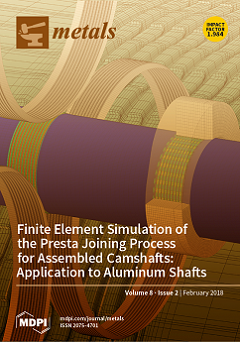Open AccessArticle
Enhanced Compressive Property of Al Composite Foams at Elevated Temperatures via Plasma Electrolytic Oxidation
by
Huamin Liu 1,2, Wenchi Pan 2, Fujian Si 2, Kuo Huang 3, Yan Liu 4 and Jiaan Liu 2,*
1
Roll Forging Research Institute, Jilin University, Changchun 130022, China
2
Key Laboratory of Automobile Materials (Ministry of Education), College of Materials Science and Engineering, Jilin University, Changchun 130022, China
3
Faculty of Engineering, University of Nottingham, Nottingham NG7 2RD, UK
4
Key Laboratory of Bionic Engineering (Ministry of Education), Jilin University, Changchun 130022, China
Cited by 9 | Viewed by 3819
Abstract
The present work investigates the compressive property of Al matrix composite foams at different temperatures between room temperature and 200 °C. Elevated temperature results in a decreased compressive strength and energy absorption capacity of as-received Al foams. Therefore, to maintain the compressive property,
[...] Read more.
The present work investigates the compressive property of Al matrix composite foams at different temperatures between room temperature and 200 °C. Elevated temperature results in a decreased compressive strength and energy absorption capacity of as-received Al foams. Therefore, to maintain the compressive property, the Al
2O
3 ceramic coating was deposited on the Al struts of the foams by the plasma electrolytic oxidation (PEO) process to form Al
2O
3/Al composite foams. As a consequence, the composite foams exhibit a higher compressive strength and energy absorption capacity as compared with the as-received Al foams at both room temperature and elevated temperatures because of the reinforced effect of the Al
2O
3 ceramic on the foam strut. The related mechanisms were explained by fractography, microstructure observation and phase composition analysis using scanning electron microscopy (SEM), energy-dispersive X-ray spectroscopy (EDS) and X-ray diffraction (XRD).
Full article
►▼
Show Figures





